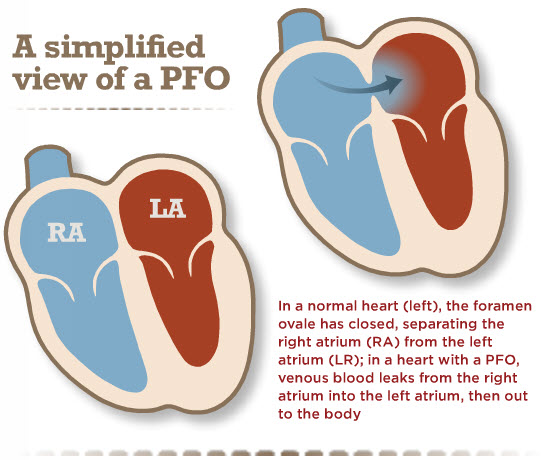Patent Foramen Ovale (PFO)
A hole in your heart would seem to be the very definition of a "problem." Yet more than a quarter of the population has one type of hole in the heart, called a patent foramen ovale (PFO), and for most people it causes no adverse health effects. In fact, the vast majority of those affected don't even know it.
Congenital heart defects can include different types of holes in the heart. One example is an atrial septal defect (ASD). Although ASD and PFO both are holes in the wall of tissue (septum) between the heart’s left and right upper chambers (atria), their causes are quite different. An ASD is a failure of the septal tissue to completely form between the atria, and as such it is considered a congenital defect — something you are born with. Generally an ASD hole is larger than a PFO. The larger the hole, the more likely symptoms are.
PFOs, on the other hand, are normal before birth but may fail to close after birth. The foramen ovale is a hole in the wall between the left and right atria of every human fetus. This hole allows blood to bypass the fetal lungs, which cannot work until air is inhaled after birth.

When a newborn takes its first breath, blood pressures change and the foramen ovale flap closes. Within a few months it has sealed completely in about 75% of us. When it remains open, it is called a patent foramen ovale (“patent” means “open”).
For the vast majority of the millions of people with a PFO, it is not a problem, even though a small amount of blood can leak from the left to the right atrium, causing a slight increase in blood flowing to the lungs.
Problems can arise when pressures within the heart change for various reasons and the foramen ovale flap never completely sealed, allowing blood to flow from the right atrium to the left. If that blood contains a clot it can travel elsewhere in the body including the brain, which could lead to a stroke.
In some cases of more complex congenital heart disease, a PFO may be helpful and necessary. The opening can allow blood to cross from one side or the other to provide necessary flow to an area that is not receiving normal blood flow.






